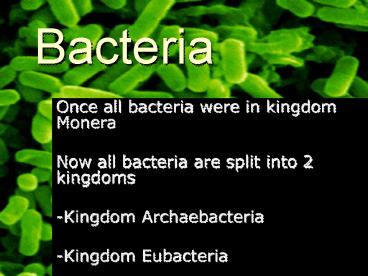Bacteria - PowerPoint PPT Presentation
1 / 27
Title:
Bacteria
Description:
Cell walls lack peptidoglycan, a carbohydrate found in the cell ... spherical (coccus or cocci) rod-like (bacillus or bacilli) helical (spirillum or spirilla) ... – PowerPoint PPT presentation
Number of Views:150
Avg rating:3.0/5.0
Title: Bacteria
1
Bacteria
Once all bacteria were in kingdom Monera Now all
bacteria are split into 2 kingdoms -Kingdom
Archaebacteria -Kingdom Eubacteria
2
Two Kingdoms of Bacteria
- Kingdom Archaebacteria
- Cell walls lack peptidoglycan, a carbohydrate
found in the cell walls of eubacteria - More like Eukaryotes than Eubacteria
- Live in harsh environments
- Kingdom Eubacteria
- Cell walls contain peptidoglycan
- Some eubacteria have a second, outer, membrane.
- Most Bacteria are Eubacteria
3
Bacteria
- All bacteria are prokaryotes
- have no nucleus
- All bacteria are unicellular
- single celled
- All have cell walls
This is two cells colonizing not a two celled
organism
4
Classifying Bacteria
- Prokaryotes are identified by their
- Shapes
- Size
- Groupings
- The ways they move
- Cell walls
- Colonization features
- Nutrition
5
Bacteria Shapes
rod-like (bacillus or bacilli)
spherical (coccus or cocci)
helical (spirillum or spirilla)
6
Bacteria Size
- Bacteria are small
- Diameter ranges between 1-5 um largest is .75 mm
in diameter
Bacteria on the point of a pin
7
Bacteria Groupings
- All bacteria are unicellular but some colonize
- Groupings can be in
- chains (strepto)
- clusters (staphalo)
Streptococcus
Staphylococcus
8
The Ways They Move
- Movement
- Brownian movement- random movement
- Spirochetes have cork-screw movement
- Some secrete slimy threads and glide along
9
Cell Wall of Eubacteria
- Eubacteria cell walls contain peptidoglycan, a
carbohydrate. - Some Eubacteria have a second, outer, membrane.
This can be determined by Gram Staining
10
Gram Staining
- Adds dye to bacteria way stains is indication
of bacterial cell wall type - Gram positive stains PURPLE has simple, thick
cell wall - Gram negative stains PINK has a protective
outer cell membrane. - Gram negatives are more resistant to
antibiotics
11
Figure 27.5x Gram-positive and gram-negative
bacteria
12
Colonization Features
- Colonies will have certain features when a
culture is grown on a petrie dish - May be smooth, rough, various colors, etc.
13
The Structure of a Eubacterium
14
Bacteria Structures
- Flagella- whiplike structure on some cells that
is used for movement - Pili- surface appendages that hold on to
substrates - Endospore- type of spore formed when a bacterium
produces a thick internal wall that encloses its
DNA and a portion of its cytoplasm
15
Bacterial Reproduction
- Binary Fission- type of asexual reproduction in
which a prokaryote replicates its DNA, and
divides in half, producing two identical daughter
cells
16
Bacterial Reproduction
- Conjugation- A form of sexual reproduction in
some prokaryotes exchange genetic information
Pili for conjugation (sexual transfer of genetic
material)
17
Nutritional Diversity
- Nutrition of prokaryote how org obtains energy
and a carbon source to build organic molecules - Categories
- Autotrophs
- a. photoautotrophs
- b. chemoautotrophs
- Heterotrophs
- c. photoheterotrophs
- d. chemoheterotrophs
18
Photoautotrophs
- Photosynthetic
- Harness light energy to make organic compounds
from CO2 - Ex. cyanobacteria
Energy From the sun
Photo autotroph
Make own organic molecules (ex. Sugars from CO2)
19
Chemoautotrophs
- Need only CO2 as carbon source
- Break down inorganic substances (nonliving
things) to get energy
Energy From the inorganic materials
Chemo autotroph
Make own organic molecules (ex. Sugars from CO2)
20
Photoheterotrophs
- Use light to generate ATP but must get carbon in
organic form
Energy From the sun
Photo heterotroph
Must eat or absorb organic molecules
21
Chemoheterotrophs
- Must consume organic molecules for energy and
carbon - Very common in prokaryotes
- saprobes decomposers that absorb nutrients
from dead organic matter - parasites absorb nutrients from body fluids of
living hosts
22
Bacteria in Nature
- Nitrogen fixation- converting nitrogen gas in the
atmosphere into a form that plants can use - Can be done by only certain nitrogen fixing
bacteria - Many plants have symbiotic relationships with
nitrogen fixing bacteria - Rhizobium is a nitrogen fixing bacteria that
symbiotic with the roots of soybean plant
23
(No Transcript)
24
Ecological Impact of Prokaryotes
- recycle nutrients (decomposers)
- Symbiotic relationships interact with other
orgs and form food webs - Cause many diseases
- opportunisitic (normal residents, but cause
disease when immune system is weak) - Bioremediation use or orgs to remove pollutants
from water, air, and soil - Ex. Sewage treatment plants anaerobic prok
- Ex. Decompose petroleum compounds at oil spills
- Act as metabolic factories for human use
- -produce acetone, butanol
- -make vitamins, antibiotics
- -food flavorings (yogurt, cheese)
- -DNA technology produce hormones like insulin
- Flavors many foods cottage cheese, yogurt, sour
cream, coffee, chocolate, butter, soy sauce
25
Preventing Bacterial Infection
- Sterilization of surfaces (with antiseptics,
heat, or steam) - Cooling, freezing food
- Dehydrating food (salt curing)
- Use chemical preservatives (food or water
chlorine) - Radiation
- Pasteurization (heating liquids)
- Canning
- Washing hands
- Antibiotics are used only AFTER have infection
present
26
Antibodies vs. Antibiotics vs. Antiseptics
- Antibodies produced by white blood cells in the
body (internal line of defense) - Antibiotics kill bacteria using chemicals that
are produced OUTSIDE of the body by other sources
then - introduced IN TO body as injection or ON TO
site of infection as surface medication
27
- Antiseptics Kill bacteria on OUTSIDE of body or
on membranes that line areas leading to inside
(ex. Mouth) - Ex. Alcohol
- Listerine
- Iodine
- Hydrogen Peroxide
- Disinfectants act as surface antiseptics for
non-living surfaces before bacteria even get to
body - Ex. Chlorox
- Lysol
- Ammonia






























